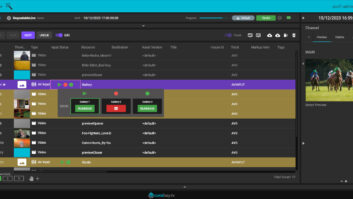Over-the-Top (OTT) viewing and subscription video on demand (SVoD) services have redefined consumer expectations for entertainment content today. Not only has the type of content that consumers want evolved, but also the way they watch it; smart connected devices are now a staple in the modern entertainment diet. Fortune Business Insights recently reported that OTT market growth will be largely driven by smartphone usage.
The rise of SVoD services further reflects consumer desires for flexible and personalised viewing, with SVoD penetration in the UK now surpassing 50 per cent. A BARB report has shown that 14.27 million UK homes now hold a subscription to at least one streaming service, while 6.67 million are subscribed to two or more.
Smart TVs are a popular way to connect to OTT services, and the promise of 4K quality has become an enticing feature for audiences. However, while TV manufacturers have long heralded the unmatched picture quality of smart 4K TVs, these devices are not being utilised to their full potential. A report from Hub Entertainment Research found that only 55 per cent of 4K TV owners in the US have used it to watch 4K content.
A lack of high-speed Fibre-to-the-Home (FTTH) broadband has meant consumers are often unable to deliver live or high demand content in true 4K. According to Cable, the recommended internet speed for live 4K streaming is 50Mbps. This means that reliable 4K streaming can be difficult to achieve, even in places like the UK, where the average broadband speed is only 22.37Mbps according to research from Ofcom.
With a reliable downstream bandwidth of up to 500Mbps, satellite is an attractive option for the delivery of 4K premium content to every subscriber – irrespective of a high-speed internet connection. Access to high quality premium content has been a major benefit of subscribing to a satellite TV service, and with SAT>IP, it becomes possible to deliver 4K on any TV screen, smartphone, games console or tablet in the home.
The technology works by taking a conventional satellite TV signal and converting it to an IP based data stream. This can then be transmitted across a standard wired or wireless IP network in the home, and viewed on multimedia and IP compatible devices, such as smart TV’s, PC’s, tablets, gaming devices and smartphones.
Access to high quality content is just one part of what makes the modern TV experience. Consumers also crave services that allow flexible viewing options across a range of devices – often at the same time. SAT>IP can help service providers deliver a modern TV experience by integrating satellite with OTT to create an innovative hybrid service. This takes the best parts of satellite delivery (high quality, guaranteed delivery) and combines it with the flexibility and personalisation of IP experiences.
Satellite TV services are commonly based on a per-household model for a bundled service delivery, and require a set-top box, cabling and HDMI enabled screens in each viewing location. Using SAT>IP will enable operators to move subscriber authentication into the device so they can offer flexible, personalised subscriptions.
Such subscriptions could include offering personalised access to content for different family members, such as a kid’s TV bundle on an iPad, premium sports and movies for the big TV in the living room and a TV show bundle on laptops. By moving to an IP/DRM based approach satellite providers can unlock this potential for second screen based subscriber options.
Service providers can also leverage SAT>IP to deploy multi-screen, multi-device 4K services within the home with relative ease, avoiding the need for customer visits to install more cabling and STBs. Once initial boxes that support SAT>IP are rolled out, there are minimal upgrade costs to unlock additional revenues. If a subscriber wants to watch TV in another room a satellite provider would, previously, need to organise engineer visits and supply additional boxes. SAT>IP future-proofs 4K deployments for the roll-out of multi-screen, with minimal service costs needed.
The rush to 4K could be a tipping point for satellite providers to find new ways to differentiate their services. The combination of satellite and IP can be the ideal route to showing what a premium 4K experience can be, regardless of broadband network capabilities. The SAT>IP Alliance membership (Arcadyan, Eutelsat, HISPASAT, Irdeto, MaxLinear, NAGRA, Panasonic, SES, Verimatrix and Zinwell) has created a whole ecosystem of easy to deploy, flexible, solutions – currently supported by over 40 manufacturers and technology companies and satellites covering 95% of the globe and reaching over a billion potential viewers.
With more live sports, movie releases and popular TV shows available in 4K than ever before, the introduction of SAT>IP is creating a huge opportunity for providers to demonstrate a compelling advantage against traditional OTT services.







